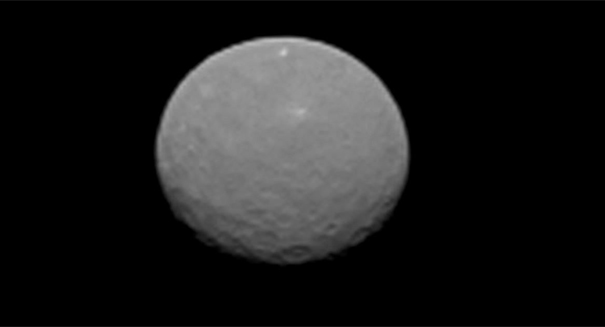
Once Dawn has all its scientific instrumentation calibrated in late April, researchers are hopeful it can help solve the mystery of its prominent bright spot.
The stunning images keep pouring in as NASA’s Dawn spacecraft draws ever closer to the mysterious dwarf planet Ceres and its bright, glowing spot — or spots.
Dawn is nearing its second and last stop after orbiting the asteroid Vesta back in 2012. The spacecraft is preparing to enter orbit of Ceres on March 6, where it will circle the 600-mile-wide giant asteroid for months collecting scientific data and hopefully answering the mystery of the bright spot on Ceres’ surface, according to a Discovery News report.
In its approach to the planet, Dawn has captured increasingly detailed pictures of the dwarf planet, including more detail of a feature that has left scientists scratching their heads: bright patches on the surface, with a particularly bright spot that has a smaller companion within an impact crater.
A few theories have been proposed as to what this phenomenon is. One is that it is an example of cryovolcanism, when sub-surface ice is forced from below onto the surface, but recent observations have thrown water on this theory. Scientists would expect that cryovolcanism would result in a “construction feature,” said Carol Raymond, Dawn deputy project scientist, as quoted in the report.
But scientists haven’t seen a mounded feature on the surface, but there doesn’t appear to be any “positive relief feature” associated with the bright spot, so therefore a cryovolcano is no longer seen as a high priority by the Dawn team.
It will likely take until late April, when the spacecraft begins its first science orbit, until researchers are likely to have a better understanding of the spot. That’s when Dawn will have its scientific instrumentation fully calibrated and ready to examine the surface of Ceres in detail.
Scientists are excited about the possibility of discovering sub-surface reservoirs of water, which is one of the mysteries surrounding the planet. Researchers believe that Ceres was on its way to becoming a planet in the early stages of the solar system, and there are strong indications that there are indeed reservoirs of water below its surface, according to the report.
Any reservoirs are likely frozen, although it may have at one point had sub-surface liquid water early on in its history. Its only source of heat is a weak amount of sunlight.
Scientists got very excited about the prospect of water on Ceres when NASA’s Herschel space telescope last year detected water vapor near Ceres — not a lot, but enough to suggest that the dwarf planet was venting water vapor from its reservoirs.
Leave a Reply